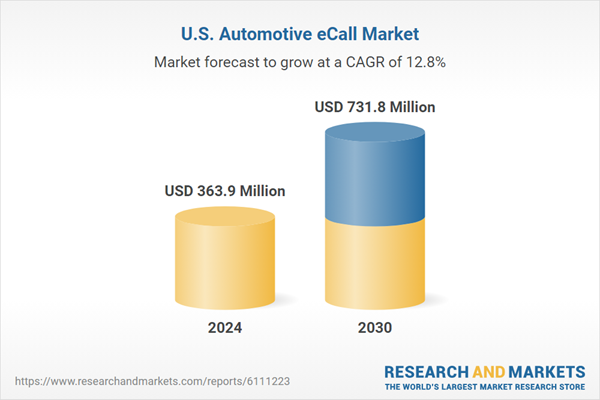U.S. Automotive eCall Market Size & Trends
The U.S. automotive eCall market size was estimated at USD 363.9 million in 2024 and is expected to register a CAGR of 12.8% from 2025 to 2030. The market is experiencing growth due to several converging drivers, primarily linked to increasing safety demands and advancements in vehicle connectivity. One of the foremost catalysts is the growing emphasis on vehicle safety from both consumers and regulatory bodies. While there is no federal mandate for eCall systems, pressure from state-level authorities and organizations such as the National Highway Traffic Safety Administration (NHTSA) encourages automakers to enhance in-vehicle safety features. This push has expanded the adoption of advanced driver assistance systems (ADAS), which also integrate eCall functionalities, helping to accelerate market growth.Consumer awareness and expectations for safety and security are also playing a pivotal role. More vehicle buyers are prioritizing safety in their purchase decisions, seeking features that can offer real-time assistance during emergencies. eCall systems, which automatically notify emergency services in the event of a serious collision, are increasingly viewed as critical components of vehicle safety. This heightened demand is further reinforced by public safety campaigns and media coverage surrounding road accident fatalities and the importance of rapid emergency response.
The relatively high rate of road accidents in the U.S. underscores the importance of rapid response capabilities. eCall systems, by automatically alerting emergency services with precise location and crash details, can significantly reduce response times and potentially save lives. This value proposition resonates strongly with consumers and policymakers alike, especially in densely populated and traffic-congested urban areas.
Original Equipment Manufacturers (OEMs) are also pushing the adoption of eCall systems as part of their product differentiation strategies. Many leading U.S. automakers have integrated eCall into broader safety and connectivity service packages, such as GM’s OnStar. These offerings are often bundled as part of premium trims or subscription-based services, adding to their appeal in the market. Additionally, the insurance industry is contributing to the growth of the eCall market by offering incentives such as reduced premiums for vehicles equipped with advanced safety systems. This aligns with the broader trend of usage-based insurance (UBI), which relies on telematics and enhances the utility of eCall systems.
Despite promising growth opportunities, the U.S. Automotive eCall industry faces several restraints that may limit its broader adoption and scalability. One of the primary challenges is the lack of a federal mandate, which leads to inconsistent implementation across vehicle classes and brands. Without regulatory enforcement, some OEMs may deprioritize the inclusion of eCall in lower-end models. Additionally, privacy and data security concerns are significant barriers. Since eCall systems rely on transmitting vehicle and location data in real time, many consumers are wary of potential misuse or breaches of sensitive information.
U.S. Automotive eCall Market Report Segmentation
This report forecasts revenue growth at country level and provides an analysis on the industry trends in each of the sub-segments from 2018 to 2030. For the purpose of this study, the analyst has segmented the U.S. automotive eCall market report based on propulsion type, trigger type, and vehicle type.Propulsion Type Outlook (Revenue, USD Million, 2018 - 2030)
- ICE
- Electric Motor
Trigger Type Outlook (Revenue, USD Million, 2018 - 2030)
- Manually Initiated eCall (MIeC)
- Automatically Initiated eCall (AIeC)
Vehicle Type Outlook (Revenue, USD Million, 2018 - 2030)
- Passenger Cars
- Commercial Vehicles
Why should you buy this report?
- Comprehensive Market Analysis: Gain detailed insights into the global market across major regions and segments.
- Competitive Landscape: Explore the market presence of key players worldwide.
- Future Trends: Discover the pivotal trends and drivers shaping the future of the global market.
- Actionable Recommendations: Utilize insights to uncover new revenue streams and guide strategic business decisions.
This report addresses:
- Market intelligence to enable effective decision-making
- Market estimates and forecasts from 2018 to 2030
- Growth opportunities and trend analyses
- Segment and regional revenue forecasts for market assessment
- Competition strategy and market share analysis
- Product innovation listing for you to stay ahead of the curve
- COVID-19's impact and how to sustain in these fast-evolving markets
This product will be delivered within 1-3 business days.
Table of Contents
Chapter 1. Methodology and Scope
Chapter 2. Executive Summary
Chapter 3. U.S. Automotive eCall Variables, Trends, & Scope
Chapter 4. U.S. Automotive eCall Market: Propulsion Type Estimates & Trend Analysis
Chapter 5. U.S. Automotive eCall Market: Trigger Type Estimates & Trend Analysis
Chapter 6. U.S. Automotive eCall Market: Vehicle Type Estimates & Trend Analysis
Chapter 7. Competitive Landscape
List of Tables
List of Figures
Companies Mentioned
- HARMAN International
- Continental AG
- OnStar (General Motors)
- DENSO CORPORATION
- Robert Bosch GmbH
- Aptiv
- Telit Cinterion
- Visteon Corporation
- Infineon Technologies AG
- STMicroelectronics
Table Information
| Report Attribute | Details |
|---|---|
| No. of Pages | 120 |
| Published | June 2025 |
| Forecast Period | 2024 - 2030 |
| Estimated Market Value ( USD | $ 363.9 Million |
| Forecasted Market Value ( USD | $ 731.8 Million |
| Compound Annual Growth Rate | 12.8% |
| Regions Covered | United States |
| No. of Companies Mentioned | 10 |









